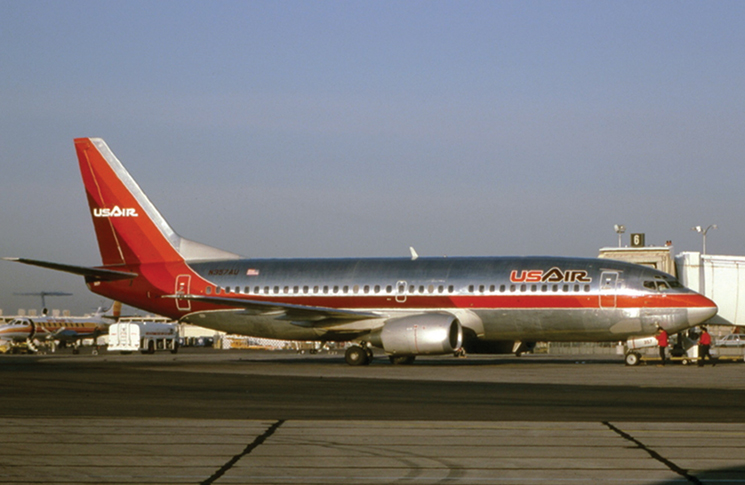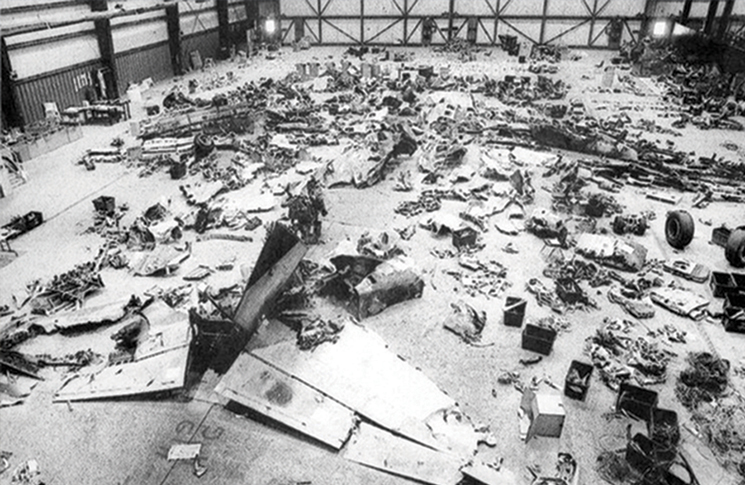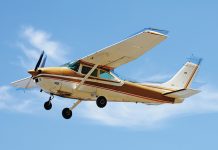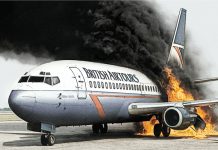In his previous career as a newspaper reporter, CASA senior media officer Steve Creedy had a first-hand view of one of the most mysterious and destructive accidents in the history of air transport.
A headline at the time summed it up: ‘Flags of red silently guard field of death.’
The flags were scattered in a sea of wreckage strewn across an area the size of 2 football fields. Each marked the position where workers combing through the debris had found human remains.
It was hard to believe that the wreckage in a picturesque valley less than 2 kilometres from a shopping centre in the Western Pennsylvania township of Hopewell had once been a Boeing 737-300.
The veteran crew had virtually no time to correct what was ultimately found to be a rudder defect.
USAir Flight 427 had been on approach to Pittsburgh International Airport on 8 September 1994 when it inexplicably rolled and took less than 30 seconds to plunge 6,000 feet. The veteran crew had virtually no time to correct what was ultimately found to be a rudder defect and were still fighting to control the aircraft only seconds before it smashed into the ground.
Captain Peter Germano was still shouting ‘pull’ just 3 seconds before the impact killed all 132 people on board. The last words, however, came from co-pilot Charles Emmett. ‘God’, he said and, 2 seconds later, ‘No’.
The crash would devastate the tightly knit Pittsburgh community, launch the National Transportation Safety Board’s (NTSB) longest running investigation, result in changes to pilot training and see Boeing modify rudders worldwide on its workhorse 737s.
But on a warm autumn day a week after the crash, it was a sobering reminder of mortality. The only pieces recognisable as part of an aeroplane were a rear stabiliser and a wing section reflecting in the sunlight at the foot of the wooded valley.
Shattered trees and a long gouge leading to the wing spoke of the force with which the Boeing 737-200 slammed into the ground at almost 270 knots.
The human impact
This was the first official visit by the media to the crash site and it was a subdued crowd of reporters, photographers and camera operators who looked over the devastating scene.
Although most of the human remains had been removed, there were still potential biohazards and we were given protective suits and masks. An official handed around a bottle of Vicks and told people to put it under their noses and in their ears.
A soft wind was blowing away from the crash scene, minimising the smell, but the official didn’t want people throwing up in their masks if it changed back towards the sombre media group.
Asked why we were putting the Vicks in our ears, she said it was because the smell could still come through the Eustachian tube. The wind did not change but none of us walked away from that valley of twisted metal and shattered lives unaffected.
The emotional impact of air crashes had been highlighted for me 2 years earlier during a visit to the parents of 2 college girls killed in the bombing of Pan Am 103 over the Scottish town of Lockerbie. It was the anniversary and the memory still reduced them to tears. When the parents of one girl pulled out a diary recovered from the crash scene, they weren’t alone.
They’d never shown the diary to anyone outside the family. It talked of the good times their daughter experienced in Scotland as well as how she was looking forward to getting back to her family in Pittsburgh. It ended in mid-sentence. Multiply that anguish many times and that was the impact on the Pittsburgh community of the 132 deaths from USAir 427.
An aircraft full of strangers crashing elsewhere in the world can be kept at arm’s length; a catastrophe in which your own people perish on your doorstep is another matter entirely.
As the newspaper for which I worked, the Pittsburgh Post-Gazette, said at the time: ‘One hundred thirty two [sic] is not just a statistic. It is the sum of the young Upper St Clair family who died together returning from a funeral; of the Russian immigrant who could cheer people up just by entering the room; of the woman who was the first black American to become president of the class at Pitt Law School; of the husband looking forward to the birth of his first child.’

A technical mystery
But what had caused this tragedy and why did the plane roll?
The aircraft had been on approach to the airport and had just levelled off after making a 14-degree left turn when it started to bank left again. It yawed left, wobbled significantly and then turned almost completely over before plunging towards the ground and hitting nose first at almost 300 mph.
Post-Gazette staff worked through several nights to produce a 16-page lift-out on the crash on 11 September that raised the possibility of a rudder problem, without ruling out other possibilities at such an early stage of the investigation.
This rudder was under the scrutiny of USAir pilots who would go as far as an unofficial late night attempt to replicate the accident in a simulator. The pilots were looking at the possibility of a rudder ‘hard over’ in which the vertical flight surface had reached its maximum deflection and stayed there.
Tests found that in some circumstances the dual servo valve could jam and produce
a rudder reversal.
As the newspaper reported at the time, rudder problems had not been definitively cited in 737 crashes but a potential rudder valve issue was under suspicion in a 1991 crash involving a United Airlines 737, Flight 585, in Colorado.
A faulty valve had also been found during a pre-flight check of a 1992 United flight that led to an NTSB recommendation calling on manufacturer Boeing to develop new pre-flight checks ahead of a design change.
Boeing had disputed the findings; the Federal Aviation Administration (FAA) had not entirely agreed and the changes urged by the NTSB did not take effect. These were divisions that would persist throughout the USAir Flight 427 investigation.
Dogged perseverance
One of the issues facing investigators was the small number of parameters collected by the aircraft’s flight data recorder (FDR).
These days, FDRs monitor hundreds of parameters but on the Loral/Fairchild Data Systems model used by Flight 427, there were just 13. This was 2 more than the 11 parameters required at the time by regulations and the NTSB would later issue an urgent recommendation that the number of parameters be increased.
As the initial investigation progressed, investigators floated several theories and shot down most of them. They included problems with a thrust reverser, the leading edge slats, the spoilers and an engine mount.
By the start of the NTSB’s public hearings in early 1995, the rudder and its control unit were a primary focus, with wake turbulence, bad hydraulic fluid and the autopilot problems yet to be ruled out.
Noises on the cockpit voice recorder were thought to be related to wake turbulence from a Delta Air Lines Boeing 727 flying 4 nautical miles ahead of Flight 427. This was seen as the start of the events that led to the upset but there was disagreement as to what happened next.
One memorable aspect of the public hearings was the tension between the Air Line Pilots Association, which mounted a strong lobbying campaign, and Boeing. The association backed the theory the crash had resulted from a rudder malfunction while Boeing was suggesting a mistake by the pilots in response to wake turbulence may have played a role.
The wake turbulence produced by a 727 was not seen as strong enough to overturn a 737 by itself and this was confirmed by NTSB research.
‘What we found was that you could take the airplane, let go of the controls and the airplane would come out of the wake, regain its composure and fly on with no problems,’ lead NTSB investigator Thomas Haueter would later tell the documentary series, Why Planes Crash. ‘There was no reason to lose control of the airplane.’
Indications that the rudder could have been involved included a yawing to the left immediately prior to the point at which the pilots lost control.
‘We knew the airplane yawed and the question was: What would cause that?,’ Haueter said. ‘And it quickly became apparent the only device that could make the airplane yaw the way it did was the rudder. That’s what it’s designed for.’
The 737 used a single power control unit (PCU) with a dual concentric servo valve to move the 737’s single rudder panel. The servo valve would respond to output from the rudder pedals or the yaw damper, a device which frequently moves the rudder to stop swept-wing aircraft fishtailing in a Dutch roll.
The valve used a slide that would line up with certain holes to direct the flow of hydraulic fluid to make the rudder turn left or right. Problems would occur if the slide jammed and holes and channels in the unit did not correctly line up.
‘If you jam the secondary valve just slightly off neutral, you could cause the valves to basically misalign and port hydraulic fluid in the wrong direction, so the rudder reversed operation,’ Haueter said. ‘This would be like driving your car and you turn to the left and your car turns right. You’re never going to figure this out before you go off the road.’
The difficulty for investigators was that valve jams often leave no evidence of the malfunction or ‘witness marks’. It would take dogged perseverance in one of the bureau’s longest-running investigations before they could arrive at a probable cause.

A puzzle comes together
A key to the report’s findings was a June 1996 incident in which an Eastwind Airlines Boeing 737-200 experienced control difficulties and rolled while on approach to Richmond, Virginia.
The board’s report, released in mid-2000, listed 46 failures and jams in the 737 rudder system.
The crew was able to maintain control and land the aircraft safely to give investigators a further insight into the 737 rudder problems. The incident prompted them to conduct further tests on PCUs, including the unit from 427.
These tests found that in some circumstances the dual servo valve could jam and produce a rudder reversal, prompting investigators to conclude in the final report that this was the probable cause for the USAir crash.
When one of the USAir 427 pilots or the yaw damper operated the rudder in response to the wake turbulence, the final report found, it most likely went in the opposite direction to the one they had commanded and also to the full blowdown limit, the furthest it could go in the flight conditions at the time.
This was ‘a result of a jam of the main rudder power control unit servo valve secondary slide to the servo valve housing offset from its neutral position and overtravel of the primary slide’. The report also found a similar problem probably occurred with United 585 and the Eastwind Airlines flight.
Boeing and the FAA did not agree with the findings, although the manufacturer had introduced modifications to the rudder in 1997 and the FAA had issued airworthiness directives. The NTSB had previously called on the FAA to ensure all existing and future Boeing 737s had a reliably redundant rudder actuation system but the expensive move continued to face resistance.
Ultimately, it was the FAA’s engineering test and evaluation board and a series of detailed tests on a tail assembly in Boeing’s Renton factory, that swung the day. In the epilogue to his forensic book on Flight 427, science journalist Gerry Byrne describes how the board’s report, released in mid-2000, listed 46 failures and jams in the 737 rudder system that could have catastrophic effect. It detailed a new threat – icing – and found even PCUs that had undergone the 1997 modifications could suffer potentially disastrous problems.
In September 2000, the FAA revealed plans to issue an Airworthiness Directive declaring the existing rudder system design unsafe and paving the way for its replacement.
By the time the NTSB issued a revised final report into United Flight 585 in 2001, Boeing had redesigned and retrofitted new PCU servo valves in all US 737s. The aerospace giant had also announced a new redesign of the rudder system to provide the ‘reliable redundancy’ called for in the USAir 427 report.






Comments are closed.